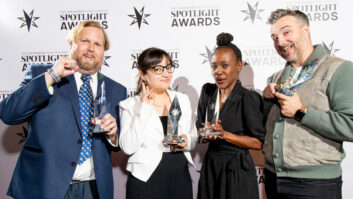
The expression “location, location, location” definitely hit me as I walked under the Wizard of Oz rainbow and onto the Sony Pictures Studios lot, in a rather unique trek to The Bakery mastering studio.
I won’t lie; I kept glancing around for stars. Eric Boulanger, owner/operator of The Bakery, says it’s commonplace to run into the megas like Seth Rogen and Kate Beckinsale. No one really reacts to them. But, he laughs, when anyone on the lot sees someone coming to work with him, like, say, Green Day, “People are passing out!”
It’s not unusual for a mastering engineer to build out a room within a larger recording facility; that happens all the time, all over the world. But a mastering studio on a major film studio lot?
“I could never do the ‘buy a house and build a studio in your garage’ thing,” Boulanger says. “I would have to hang myself. It sets you off from the world. That’s not music, locking yourself in a room and working on people’s pride and joy. It’s antithetical to what you’re doing. My mind was thinking that I had to be in a place that’s a center of art—any type of art. It didn’t have to be the middle of rock ’n’ roll land. It just had to be creative people going to work.”
The opening of The Bakery in August 2015 followed the closing of the world-renowned The Mastering Lab, Doug Sax’s facility in Ojai, about 90 miles north of Los Angeles, where Boulanger had worked since moving west in 2007.
A classically trained violinist, Boulanger had studied at Juilliard School, Manhattan School of Music and Tanglewood, at various times, and was finishing up an electrical engineering degree at Carnegie Mellon University in Pittsburgh when he took an unpaid internship at Capitol Records in 2006, under the tutelage of Al Schmitt, an experience he calls “second to none.”

Eric Boulanger and Jett Galindo at their stations in The Bakery. Note the dual monitoring setups, front and back.
“I was always a bit of a techie and a little bit into recording, and honestly I went to Carnegie Mellon because, as a violinist, it was the best university I got into,” Boulanger says, noting that while he didn’t love the routine and daily grind of academia, the minute he walked into the university’s recording studio, he felt at home.
While at Capitol, Schmitt introduced Boulanger to Doug Sax, who granted him his first real exposure to the mastering process and ended up hiring him the following year. Sax recognized the talent, even with no mastering experience, and served as his mentor. In early 2009, when Sax decided to resurrect The Mastering Lab’s vinyl operation and build out a space for the lathe, he called on Boulanger to assist, from reconditioning the machine to solidifying the platform.
The process was not without its irony, however; Boulanger had never owned a record album.
“One of my favorite moments was when we were about 85 percent through the build,” Boulanger recalls. “No sleep, working through the night. Doug lived real close in Ojai and it was about 11:45 at night and he stumbled in, ‘What the f— are you doing here?’ And I said, ‘Putting together your room.’ He’s pouring the whiskey, wanting to hang and I forgot how we got into the conversation but he was talking about buying records as a kid. I cut him off, saying, ‘You have to realize something here…you know how when you’re in sixth grade and you have a little money in your pocket and you go with your friends to the record store and you buy an album? You know what I bought?’ He starts rattling off bands. I said, ‘You’re missing the point, I bought a CD.’”
The years went by in Ojai. Boulanger learned mastering from a master. He learned vinyl cutting from its foundation. He began getting his own clients. And like a lot of young engineers, he began looking outside, thinking of setting up his own shop.
As a violinist, Boulanger had played many sessions on Sony’s Barbra Streisand Scoring Stage, and he became friends with staff mixer Adam Michalak. In early 2014, over dinner, Boulanger confided to Michalak that he had begun looking for a place to land. Michalak suggested Sony, and during a scoring session soon after, they took a tour. The audio post editing suites proved too small, but at an impromptu meeting with Tom McCarthy, executive vice president of post production, talk turned to a couple of screening rooms that were not in use.
All systems were go, Boulanger was about to break the news, and then Sax got sick. What he thought was food poisoning turned out to be stage four cancer. “He was in surgery the next week and that totally distracted me to everything,” Boulanger says. “We wanted to keep that business going.”
Sax passed away in April 2015; The Mastering Lab closed in May 2015. The end of one era, and for Boulanger, the start of another.
THE MOVE TO SONY
The Thalberg Building’s 25-seat 35mm film projection Screening Room E hadn’t been used in about 10 years and proved perfect for Boulanger’s proposed setup. He even retained a few of the theater seats and pillars on the wall to preserve the old Hollywood ambience. He moved into the space in July and was up and running by August. “I didn’t sleep much,” he recalls.
“It was already treated because it was a screening room,” he explains. “The acoustic aspect of getting it right was in the placement of everything. I played around with that and got everything to my liking, built stands and platforms.”
He wasn’t entirely alone during the move-in. Jett Galindo had been Doug Sax’s right hand during the final two years at The Mastering Lab, as an assistant and as an engineer. Born in the Philippines, where she earned a degree in psychology at Ateneo de Manila University, she’s also a performing soprano and Berklee College of Music graduate in Music Production and Engineering. She interned at Avatar in New York City before moving west and joining the Ojai team. She was privy to Boulanger’s intended move, and following the closure, she came down and started helping out. In one of those situations where it’s going so smoothly that a job was never really offered or accepted, at least officially, Galindo joined The Bakery as a mastering engineer—a colleague.
The dimensions of the main mastering room, roughly 34 by 20 feet with 16-foot ceilings, were perfect for Boulanger’s ATC 150 speakers, with stands that are filled with 650 pounds of sand. They are set behind his main mix position, a trick he learned from Sax, who began orienting his speakers that way after the move to the Ojai studio, following some 40 years of mastering.
“He always wanted to try it that way,” Boulanger says. “It also came from building the room from scratch. What’s the biggest acoustical obstacle to room tuning? It’s always the console. You’ve got this hunk of metal between you and the speakers. Well, why don’t we put it behind us? Genius.”
Actually, Boulanger says he learned his entire approach from Sax. Most importantly, he says, he learned how to listen in the sense of being analytical and taking a step back to understand that everything is in play and that “what you hear is king.” Sax’s favorite expression, Boulanger says, was, “If it ain’t broke, don’t fix it,” something he took to heart when building the room.
“When not touching a perfect mix, Doug’s philosophy isn’t to stroke a mixer’s ego,” he says. “You’ve already done the work. That work is the studio. I know what I’m listening to. The only way to do that is to have the proper setup, the proper methodology and constant attention and maintenance to the room.”
Boulanger has a Manley Massive Passive EQ, but the majority of his equipment is highly modified. He has clone LA-2As with his circuit in them and a slower light cell. A lot of the equipment is, as he says, “akin to what we had at The Mastering Lab, so it’s more of a flat response. It’s meant to only tickle things as opposed to be an aggressive vocal compressor which the LA-2A was meant for.”
In the center, “the real magic of everything,” Boulanger says, are the tube and solid-state line amps built by himself, which work in tandem with custom D/A and A/D converters made by Josh Florian of JCF Audio to his specs.
“The beauty of this console is whether I am doing fully analog or full digital or a mixture of both, which is usually what I do, I can, with a flick of a switch go between all these parallel chains and hear exactly what I’m doing and decide what will sound better for what I’m working on,” he says. “That was all in the design of this layout. It was a function I always wanted at the Mastering Lab. We had all the same processes, but to compare things we had to print one way, plug things in differently and print it the second way and then compare it.”
The system apparently works. Boulanger’s first chart-topping project out of The Bakery was Kaleo’s “Way Down We Go,” followed by Green Day’s Billboard Number One album Revolution Radio, Rufus Wainwright’s Take All My Loves (“A true compositional masterpiece, which made mastering it my greatest challenge”), and the soundtrack for the Ryan Gosling/Emma Stone film La La Land.
THE VINYL SIDE
Up in the projection booth, on top of an isolated slab so solid that “a herd of bison could run down the hall and you wouldn’t feel it,” says Boulanger, sits the creme de la crème: a digital vinyl cutting lathe previously owned by Stan Ricker and pictured on this month’s cover.
In a full-circle story, Boulanger had visited Ricker in 2009 when Sax reopened his vinyl cutting operation and Boulanger needed some tutelage and the control panel needed repair. A few years later, Ricker needed some tech help with his system and called upon Boulanger, who then repaired the very same system that is now his.
“What powers the head is our custom design,” Boulanger says. “All the processing is being done digitally, all DSP. The beauty of that is we can instantly, depending on speed, size, whatever you’re doing, switch EQ profiles for a record. If you ever noticed on vinyl records from the outside to in, they’re bright to dark because of the geometry.”
Affectionately dubbed “RoboLathe,” it earns its name. After opening a Colbie Caillat file for a song called “Stay,” Boulanger had me push a few buttons on the machine to show me just how simple and precise it can be to cut a record on his lathe. Then we went out into the main room and listened back to the vinyl on his ATCs. It sounded amazing.
“Stay” is from Caillat’s most recent project, The Malibu Sessions, a selection of stripped-down acoustic songs recorded three years ago but just recently released on her own label. It is Boulanger’s seventh project with Caillat, including All of You, the first record to employ the Mastered for iTunes process back in 2011. Today, Boulanger and Caillat consider themselves friends. This month, they share the cover of Mix.
For Boulanger, it’s all about the passion of music.
“There’s no greater thrill than saying to Billie Joe (Green Day lead singer Armstrong) who I grew up on, ‘I think you need to change this,’ and then sitting next to him and saying, ‘Oh, yeah, you’re totally right,’ to being on a scoring stage playing on a Ted 2 movie where we did a quick cue of the original Jurassic Park theme and I was dying thinking, ‘Half of these guys even played on the original,” Boulanger recalls. “‘This is the closest thing to doing it.’”







